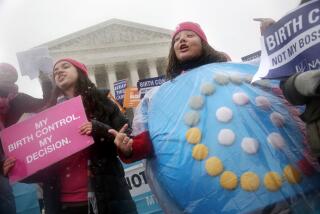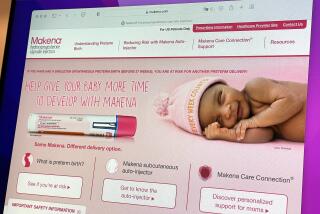A Long-Feared Drug Gets the Green Light
WASHINGTON â On Sept. 5, 1997, a Food and Drug Administration panel met to ponder the once-imponderable: Should thalidomide be approved in the United States?
Decades earlier, the pillâs use abroad as a nighttime sedative by expectant mothers had resulted in the gruesome disfiguring of thousands of newborns. The FDA medical officer responsible for keeping thalidomide off the U.S. market, Dr. Frances O. Kelsey, was honored as a national hero in 1962 by President Kennedy.
Thirty-five years later, the Celgene Corp. was seeking FDA approval of thalidomide, ostensibly for an extremely narrow use: treating the complications of leprosy.
The agency already allowed experimental use of the drug for leprosy and AIDS, and some of these patients saw improvements in skin growths or sores. But the drugâs effectiveness remained unproven. A study published by the New England Journal of Medicine in May 1997 found that some AIDS patientsâ underlying disease worsened on thalidomide, compared with those who took a placebo.
Unlike at most advisory meetings, the top administrators at the FDAâs drug-review center--Dr. Janet Woodcock and her deputy, Dr. Murray M. âMacâ Lumpkin, took seats at the U-shaped conference table. Agency administrators had encouraged Celgene in 1995 to test thalidomideâs potential, following interest and illicit distribution of the drug among AIDS patients.
None of the three FDA medical officers who reviewed thalidomide supported approval. Drs. Kathryn OâConnell and Brenda Vaughan and their boss, Dr. Jonathan Wilkin, found that the studies submitted by Celgene failed to establish effectiveness or safety.
Wilkin, director of the dermatology drugs division, worried that Celgene would seek a far broader market for thalidomide. Once a company wins approval for a new drug, the compound may be prescribed lawfully for any medical purpose.
âIf there are two dozen new patients a year that are going to be using thalidomide for [leprosy], then that hardly seems to me to be a profitable market,â Wilkin told the FDAâs Dermatologic and Ophthalmic Drugs Advisory Committee. âSo, the question is where is this really leading? I think that off-label use is where the vast majority of the use would occur. It would dwarf actually the use forâ leprosy.
Wilkin decried the absence of any scientifically acceptable study supporting Celgeneâs application. He warned of the drugâs capacity to severely damage white blood cells and the central nervous system, including among AIDS patients. Wilkin flatly told the advisory committee that thalidomide was ânot approvable.â
Just as Wilkin finished speaking, Lumpkin raised his left hand to be recognized.
âI just donât want there to be any misunderstanding within the public that what youâve heard is, quote unquote, the agencyâs recommendation,â he said, adding: âWhat the primary reviewer, what the secondary reviewer, what the division director have done is given us their opinions and thatâs part of the equation. . . . They are not the deciding officials.â
The advisory committee voted 8 to 1 that the benefits of thalidomide outweighed the risks. On July 16, 1998, the agency approved thalidomide, declaring it âwill be among the most tightly restricted drugs ever marketed.â
At Celgene, the top executive credited Woodcock and Lumpkin for trumping the presentations of division director Wilkin, and medical officers OâConnell and Vaughan.
âCertainly there was a lot of concern on our part that in the end the FDA would decide not to approve thalidomide based on some of those presentations,â said John W. Jackson, company chairman and chief executive officer. âHowever, we were confident that the senior people at the FDA had encouraged us. . . . They felt that it should get approved and be on the market.â
Jackson added: âThey felt . . . there was a need for this drug in the AIDS community.â
Celgene from the outset promoted thalidomide for purposes having nothing to do with leprosy, including the treatment of various cancers, officials later alleged. On July 30, 1998--just two weeks after thalidomide had been approved--officials working in the FDAâs drug-marketing office contacted Celgene and expressed concern about the companyâs promotion of thalidomide for uses âother thanâ the narrow, approved treatment of leprosy.
On April 21, 2000, the director of the marketing office, Thomas W. Abrams, wrote to Celgeneâs Jackson, alleging that the company âis demonstrating a continuing pattern and practice of violative behavior.â Abrams added: âCelgeneâs actions are particularly troublesome. . . . Perhaps more than for any other available drug, the need to provide and distribute thalidomide responsibly is essential to the public health.â
Jackson said in an interview that Celgene âhas never advocated any off-label promotion [for thalidomide]. Our objective was and always has been to comply fully with the rules and regulations of the FDA.â
After the FDAâs approval of thalidomide, the drug gained virtually no popularity in treating AIDS patients. Jackson said that thalidomide is now being used âalmost entirelyâ for treating various cancers.
Reports filed with the FDA since the drugâs approval cited thalidomide as a suspect in 16 deaths from the July 1998 approval through June 2000. Three of those who died, women ages 56, 59 and 63, had a white blood cell disorder, neutropenia, about which Wilkin had warned the advisory committee.
Jackson said the deaths were unsurprising because thalidomide is used to treat extremely sick patients. He said that special controls for dispensing the drug have proven a success and that no birth defects have emerged. Doctors and pharmacies must register with Celgene before dispensing thalidomide, and each new patient is supposed to view a video showing the flipper-like limbs that can result from use during pregnancy.
Agency officials declined to allow Wilkin, OâConnell or Vaughan to grant interviews for this article. The FDA also has declined for more than a year to provide their medical reviews, requested under the Freedom of Information Act.
Said a specialist familiar with those documents, who spoke on condition of anonymity: âThe reviewers looked at the data set, considered the public health and did what they thought best. . . . If youâre looking for differences between upper management and the reviewers--read the reviews.â
An FDA spokeswoman, Rae Jones, said the prospect of off-label use âhad no bearingâ on the agencyâs decision to approve thalidomide.
When thalidomide was approved, securities analysts predicted that it could generate annual sales of $300 million by 2004.
(BEGIN TEXT OF INFOBOX / INFOGRAPHIC)
Methodology: How Deaths Were Calculated
Reports of adverse drug reactions to the Food and Drug Administration are considered by public health officials to be the most reliable early warnings of a productâs danger. The reports are filed to the FDA by health professionals, consumers and drug manufacturers. The Los Angeles Times inspected all reports filed in connection with seven drugs that were approved and withdrawn since 1993. By hand and by computer, The Times counted 1,002 deaths in which the filer identified the drug as the leading suspect. Since fall 1997, this top category has been termed âprimary suspect.â The Times did not count any death in which the drug was identified as the âsecondary suspectâ or less. The methodology and results were reviewed by Sheila R. Weiss, a former FDA epidemiologist who is an assistant professor at the University of Marylandâs department of pharmacy practice and sciences.
Contributors:
Researchers: Janet Lundblad, Sunny Kaplan
Graphics: Rebecca Perry
Photographer: Brian Walski
Graphics editor: Chris Erskine
Photo editor: Steve Stroud
Design director: Joseph Hutchinson
Editors: Roger Smith, Nan Williams, Steve Devol, Bobbi Olson, Kathie Bozanich







